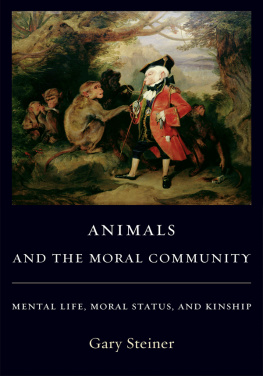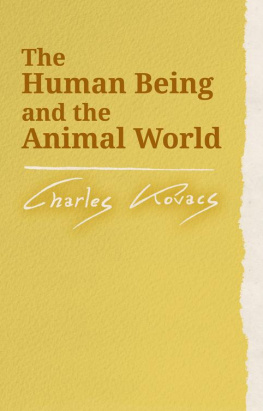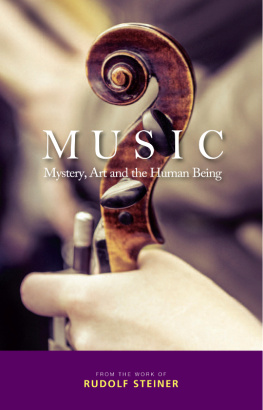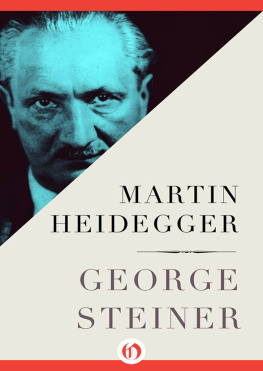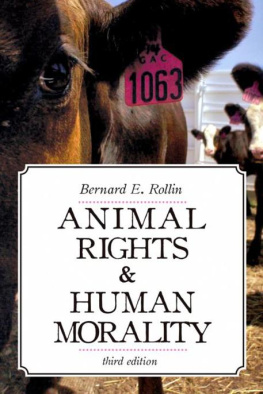ANIMALS AND THE MORAL COMMUNITY
ANIMALS AND THE MORAL COMMUNITY
MENTAL LIFE, MORAL STATUS, AND KINSHIP
Gary Steiner
COLUMBIA UNIVERSITY PRESS NEW YORK
COLUMBIA UNIVERSITY PRESS
Publishers Since 1893
NEW YORK CHICHESTER, WEST SUSSEX
cup.columbia.edu
Copyright 2008 Columbia University Press
All rights reserved
E-ISBN 978-0-231-51260-2
Library of Congress Cataloging-in-Publication Data
Steiner, Gary, 1956
Animals and the moral community : mental life, moral status, and kinship / Gary Steiner.
p. cm.
Includes bibliographical references and index.
ISBN 978-0-231-14234-2 (cloth : alk. paper) ISBN 978-0-231-51260-2 (e-book)
1. Consciousness in animals. 2. Animal psychology. 3. Animal welfareMoral and ethical aspects. 1. Title.
QL785.25.S74 2008
179.3dc22
2008008299
A Columbia University Press E-book.
CUP would be pleased to hear about your reading experience with this e-book at .
For Pindar, who teaches me every day about the meaning of kinship
CONTENTS
In all essential respects, the animal is absolutely identical with us. The difference lies merely in the accident, the intellect, not in the substance which is the will. The world is not a piece of machinery and animals are not articles manufactured for our use.
SCHOPENHAUER, On Religion
There is a long and regrettable history of thinking in the West according to which human beings are morally superior to animals and hence enjoy the prerogative to use animals for whatever purposes they see fit. A predominant tendency in this thinking is to suppose that our putatively superior intellect entitles us to treat animals as if they were created to satisfy our desires. Some philosophers have argued for human moral superiority on the grounds that animals possess certain cognitive capacities but lack reason, while others have maintained that animals are devoid of cognitive capacities and are subject entirely to instinct. In both cases the grounding assumption is that capacities such as language and abstract thought, which enable us to relate to the distant future and remote past and to engage in conceptualization and planning, confer on us a unique status: that of the central and most important being in creation. Even Schopenhauer, who recognized that animals are identical to human beings in striving to flourish according to their natures, succumbs to this anthropocentric prejudice when he asserts that it is the mind that makes man lord of the earth.
In recent years philosophers and ethologists have begun to challenge this prejudice by taking seriously the idea of animal cognition and by emphasizing the continuities rather than the differences between the mental lives of human beings and animals. According to the dominant traditional logic, a beings moral status is a function of the cognitive skills that being possesses; human beings possess the highest moral status in virtue of their rational and linguistic capacities, whereas animals possess an inferior moral status in virtue of lacking these capacities. Recently this logic has begun to shift: it is increasingly common for philosophers to argue that animals possess much more sophisticated cognitive abilities than was previously recognized, and that animals therefore enjoy a higher moral status than was previously thought.
Thinkers who endorse this newer logic continue to subscribe to the old assumption that superior cognitive abilities are the basis for superior moral status. In their zeal to elevate the moral status of animals, such thinkers, if only unwittingly, attribute more sophisticated mental capacities to animals than they actually seem to possess. In particular, such thinkers tend too often to assume that mental life is an all-or-nothing affairthat a being either possesses all the capacities of rationality, such as reflective self-consciousness, or that it possesses none of them. To the extent that it is implausible to explain many sorts of animal behavior on the basis of blind instinct, the thinking goes, the only reasonable alternative is to attribute to animals sophisticated capacities such as conceptual thought and predicatively structured mental states such as belief.
In the first half of this book I challenge this line of thinking on the grounds that most if not all animals seem to lack the capacity for abstract thought. It is in virtue of abstract, conceptual thought that humans are able to form complex plans and intentions, and to represent to themselves moments of time far removed from the present. Because animals cannot communicate with us through language, we can never be certain about the precise nature of animal experience. This problem is compounded by the fact that different animals have different types of experience. Hence we must be careful in making generalizations to the effect that all animals experience the world in exactly the same way. Nonetheless, some tentative generalizations can be made and put to the test in empirical observations of and encounters with animals.
A common basis in contemporary thought for attributing rational capacities to at least some animals is physiological similarity and evolutionary continuity between humans and animals. It seems plausible to suppose that there are basic similarities between human and animal experience. But in making this supposition, we need not rush to assume that animals are rational. Another way to approach the problem is to recognize that a great many human mental operations and behaviors occur at a sub- or pre-rational, pre-linguistic level, and that this level of experience is really what makes animals most like us from a cognitive standpoint. After examining some key debates in contemporary philosophy and ethology concerning the nature of animal cognition, I conclude the first half of this book by sketching a theory of the mental lives of animals that appeals to Humean associations rather than to conceptual and predicative abilities in the endeavor to account for animal behavior. The closer an animal lies to the putative dividing line between human and nonhuman, the less this model will apply to that animal; empirical observation and reflections on evolutionary continuity suggest that some animals, particularly apes and dolphins, are capable of highly sophisticated mental operations that more closely resemble human cognition than do the mental operations of other animals. But animals more typically seem not to possess such capacities, and in the case of those animals there is a need for a model of mental life that does not take its bearings from human rationality.
The other major theme I take up in this book is the proper basis for establishing the moral status of animals. I reject the traditional prejudice that moral status is in any way a function of cognitive capacities. I argue instead that sentiencethe capacity to experience pleasure and suffer painis a sufficient condition for equal consideration in the moral community. But instead of proceeding on utilitarian or traditional animal rights grounds, I argue that sentience is a capacity shared by all beings for whom the struggle for life and flourishing matters, whether or not the being in question has a reflective sense of which things matter or how they matter. Sentient beings, both human and nonhuman, have a kinship relation to one another that binds them together in a moral community in which neither can properly be said to be superior or inferior to the other. One of the greatest challenges for this theory of kinship is how to affirm it without sacrificing the achievements of liberal political theory. In a society in which our sensibilities have been shaped for millennia by the idea of absolute human superiority over animals, how can we be brought to acknowledge our fundamental moral obligations toward animals without being forced to do so through absolutist totalitarian means? I conclude the second half of this book with a discussion of how this might be achieved.

